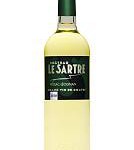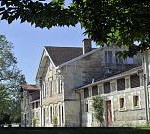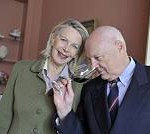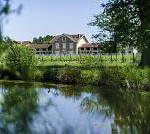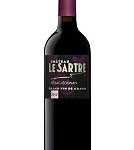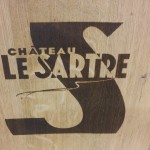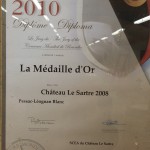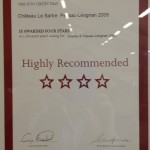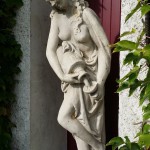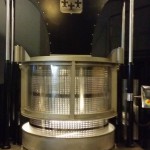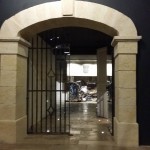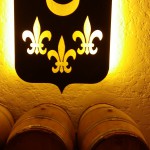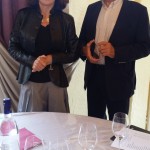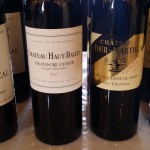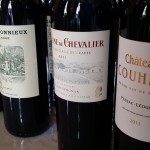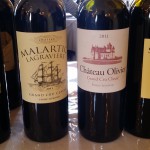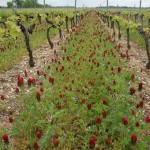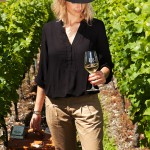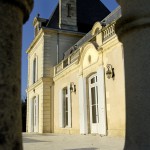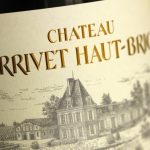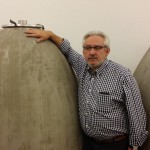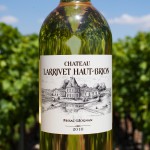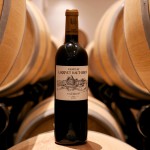DAY TWO
Day two was spent exclusively in the Pessac-Léognan appellation.
My first stop was at Château Le Sartre in Léognan. This estate originally belonged to the Perrin family of Château Carbonnieux and since 2004 has been managed by Marie-José Perrin-Leriche and her husband, René Leriche, assisted by the Burgundian Jules Guyot. The 36 hectares are mostly planted with red wine varieties (12 ha. Cabernet Sauvignon, 12.7 ha. Merlot, and 1.1 ha Cabernet Franc), but there are also 10.2 hectares of white wine grapes (8.2 Sauvignon Blanc and 2 ha Sémillon). The vines are an average age of 20 years old.
The main 26-hectare plot is located in a single block south of Fieuzal and east of Domaine de Chevalier. The terroir here is ideal for Cabernet Sauvignon and Merlot. Unfortunately, it is also prone to frost damage, and Le Sartre produced only a quarter of a normal crop in 2011… That is why you see wind machines here, like in California.
A second 7.6 km plot, one km. away, between Fieuzal and Malartic-Lagravière, as well as a small 1.7 hectare plot near Carbonnieux, have more early-maturing terroirs and are less subject to frost damage.
Things are stirring at Le Sartre. The cellar has state-of-the-art winemaking equipment and the château building is being entirely renovated. Furthermore, the wine is finally gaining the reputation it deserves and is definitely one to watch out for! The French wine critic Jean-Marc Quarin includes Le Sartre in a group he calls “the Outsiders” – wines currently undervalued and well worth following. I couldn’t agree more with his analysis…
I went from Le Sartre to Ch. Smith Haut Lafitte, where a major tasting of red Pessac-Léognan wines had been organized. M. and Mme Cathiard could only greet us at the end because an Air France strike had prevented them from arriving any earlier.
Smith Haut Lafitte is geared up to receive visitors in an almost New World way, with knowledgeable staff and facilities suited to tours. The château’s improvement over the past 20 years is one of Bordeaux’s great success stories.
Here are my notes from the tasting, once again leaving out references to color, which was invariably good for these young wines:
RED PESSAC-LEOGNAN WINES
2011 Ch. de Léognan
Nose: soft, simple, straightforward
Palate: shows candied fruit, but does not develop a great deal on the palate. Marked acidity, but still shows good balance.
2011 Lespault-Martillac
Nose: subtle and fairly earthy, with penetrating black cherry aromas and an ethereal spirity side
Palate: chewy with nicely-grained tannin and lively acidity. Shortish aftertaste with liquorice overtones. Good to drink young.
2011 Gazin Rocquencourt
Nose: understated sweet cherry and cranberry sauce aromas
Palate: lovely balance and lip-smackingly good. Great acidity and cherry-vanilla flavors. Not a show stopper, but a wine lover’s sort of wine, with a long aftertaste and just the right amount of oak.
2011 Carmes Haut Brion
Nose: classic, discreet oak, with the fruit just starting to come through
Palate: rich, a little weak on the middle palate and with a certain dryness on the aftertaste due to barrel ageing. However, I would like to give this wine the benefit of the doubt, and hope that everything comes together well in a few years’ time.
2011 La Louvière
Nose: lovely soft cherry-vanilla aromas. Irreproachable.
Palate: lively acidity and good tannic texture. Digestible sort of wine. The oak should even out, but it contributes to a dry finish at present. One of the better wines at the tasting.
2011 de France
Nose: great, typical Graves with a vivacious, rich, fruity bouquet but too much oak comes through at this stage.
Palate: Round, big, full-bodied, with a velvety texture and a nice lift. Question mark about the oak.
2011 Luchey Halde
Nose: pretty, deep, and brambly, with dark fruit
Palate: round, juicy, up-front attack with good acidity to follow. Well-made wine with a great tang on the finish. Although it lacks richness and voluptuousness, it is still very good with a lovely cherry lozenge finish. Thank goodness the oak is low-profile. One of the best wines in the tasting.
2011 Rouillac
Nose: straightforward, “petits fruits rouges” and primary fruit
Palate: light and fluid, uncomplicated, with an aftertaste that adds seriousness to the wine.
2011 d’Eyran
Nose: fine fresh forest fruit bouquet, beguiling, lovely. Mercifully not too much oak, but some roast coffee aromas.
Palate: plush and melts in the mouth, but underpinned by good acidity. Some (but not too much) oak on the long, textured finish. Traditional, however not one for the long haul. Nice discovery and one of the best wines.
2011 Haut Bergey
Nose: attractive and classy. Sweet plum and berry fruit.
Palate: mouth-filling, but falls down somewhat on the middle palate. Too much oak on the aftertaste. One has the impression of prime fruit that has seen too high a percentage of new oak barrels.
2011 Olivier
Nose: fine bouquet. Deep, inky, with somewhat unexpected honey nuances!
Palate: starts out round, and plush, but proves to be weak on the middle palate. The oak ageing is over-ambitious.
2011 Bouscaut
Nose: sweet cedar and slightly confected fruit. Very good and concentrated.
Palate: Starts out nice, rich, and supple going on to show good acidity . Fine tannic texture. Great to see Bouscaut on the upswing and this was one of the best wines of the tasting.
2011 La Tour Martillac
Nose: a little spirity and closed in at the moment
Palate: soft, a little dilute to start off, but segues into a wine of character with a fine aftertaste. Elegant tannin and oak under control.
2011 Couhins
Nose: sweet with good oak
Palate: melts in the mouth, then proceeds to follow through well with authority and good acidity. Nice oak background and a good finish. Thirst-quenching wine of distinction. Recommended.
2011 Couhins Lurton
Nose: ripe, fresh, and pure, with a subtle perfume
Palate: serious wine. Great balance. Very representative of its appellation. Velvety texture. One of the best wines. Only a certain diluteness and weakness leading up to the aftertaste keep it out of the very finest category, but nevertheless a wine to reckon with.
2011 Carbonnieux
Nose: discreet but promising
Palate: mouthfilling with good acidity, as well as nice texture and length. A tad dry, though.
2011 Malartic Lagravière
Nose: subtle, fresh, and brambly with understated oak
Palate: rich and melts in the mouth, but provides a fresh fruit tang on the aftertaste. Sensual. One of the best of the tasting.
2011 Haut Bailly
Nose: brilliant, nuanced, and classy with well-integrated oak
Palate: tightly-knit, superb balance, with deep dark fruit flavors. Wonderful, and my finest score.
2011 Smith Haut Lafitte
Nose: pert, perfumed, uplifting, and not too oaky, with fine berry aromas
Palate: mouthfilling and delicious, neither over-extracted nor over-oaked. Touch dry on the finish, but this is indeed a fine wine.
2011 Domaine de Chevalier
Nose: sweet and subtle with floral and berry overtones
Palate: light on its feet and refreshing due to lively acidity. Superb, a sort of sublime luncheon claret. Fine, textbook Graves.
After the tasting, I was invited to a lunch at Château Larrivet Haut Brion hosted by Emilie Gervoson, Bruno Lemoine, and his daughter, Alice, who runs the boutique.
Larrivet Haut-Brion has a fantastic terroir very close to Haut Bailly, and the estate is truly lovely, including an imposing château, landscaped grounds, and a pond with swans and a fountain…
Emilie Gervoson is the new face of Bordeaux: young, bouncy, given to wearing jaunty hats, and diametrically-opposed to the prim, proper, and slightly boring variety of Bordelaise (she’s actually Parisienne)…
The Gervosons made a fortune in jams and fruit-based desserts and still own the family firm (Andros). Bruno Lemoine was formerly manager at Ch. Montrose, and responsible for making the legendary 1990. He has been in charge of Larrivet Haut Brion since 2008. Michel Rolland is the consulting enologist.
Bruno has changed things considerably and is totally open to new methods, including “concrete eggs”.
Our dinner conversation was free-wheeling and far-ranging, including such controversial subjects as Isabelle Saporta’s book, Vino Business. The wines (2010 white and 2006 red) showed very well and dynamic changes taking place at present bode well for this superbly-located estate.
The next stop was Château de France, where we were welcomed by the owner, Arnaud Thomassin. However, there was not to be a tour of his château. Instead, we tasted through a line-up of white Pessac Léognan. Here are my notes for the 12 wines I tasted:
2013 WHITE PESSAC-LEOGNAN WINES
It was also explained to me that Pessac-Léognan is only twice the size of Pomerol, one of the smallest appellations in Bordeaux – and that only 15% of the wine is white. Furthermore, at several prestigious estates, it is worth noting that the white costs more or considerably more than the red…
2013 Grandmaison
Nose: very varietal Sauvignon Blanc characteristics, but not much else there
Palate: better, lemony, tart, fresh, and good
2013 Luchey Halde
Nose: attractive and expressive with peach and floral overtones
Palate: clean, sprightly, tart, surely even better with food
2013 Couhins
Nose: grassy and not saying much at this time
Palate: sharp and not very fruity
2013 Couhins Lurton
Nose: very varietal Sauvignon Blanc, but not in an exaggerated way
Palate: fuller and richer than expected after the nose, and showing good balance. Ripe, fresh, and clearly one of the better wines at the tasting.
2013 Smith Haut Lafite
Nose: understated
Palate: silky and “sweet”, with good oak. What the French call “un vin de gastronomie”. Persistent aromatics. Not overdone in any way, tremendously well-balanced and refined. Tied for first place in my notes, and far from some of the overdone versions of SHL I’ve encountered in the past. Congratulations!
2013 Fieuzal
Nose: tropical fruit
Palate: round and more of a pronounced mouth feel than most of the other wines. Svelte and dry, with citrus overtones. Quite fine.
2013 Malartic Lagravière
Nose: characterful with discreet tropical fruit, and like nothing so much as a dry Sauternes
Palate: mouthfilling with resinous nuances sliding into a beautiful mineral finish. Seriously good, and tied with the Smith Haut Lafitte for wine of the tasting.
2013 Bouscaut
Nose: classic, with beeswax and lemon nuances
Palate: lanoline, vanilla, and clove going into an unexpectedly pronounced mineral finish coming into its own after a little flabbiness on the middle palate. This should not imply this was not a very good wine, because it was. Between this white and the red I tasted the day before, I applaud the renaissance at Bouscaut!
2013 Lespault Martillac
Nose: seemed a bit chemical and technical. The bouquet is fresh and there’s some lemon there, but it lacks definition.
Palate: good, soft attack but empty on the middle palate. Penetrating vibrant acidity.
2013 La Louvière
Nose: fresh, but closed in at this stage.
Palate: fairly mineral with an acid edge. Good, but needs to age.
2013 La Garde
Nose: very varietal Sauvignon Blanc, and somewhat in your face
Palate: round, commercial style. Little obvious and with a salty finish.
2013 Rouillac
Nose: soft and enticing
Palate: softness here as well for this elegant wine that segues into a mineral aftertaste showing the intelligent use of new oak. A really nice discovery for me.
The day ended with a gala dinner at Château de Fieuzal for a group of about 100 or 120 people. This was all of a 10 minute walk from Ch. de France and it was a joy to go there on foot and admire the ripe grapes on the way.
I enjoyed a memorable evening with Véronique Bonnie-Laplane of Malartic Lagravière, Fabien Teitgen of Smith Haut Lafitte, Francis Boutemy of Haut Lagrange, Rémi Edange of Domaine de Chevalier, Emmanuelle Jeannerot of the Pessac-Léognan Syndicat, Philippe Miecaze of Ch. de Léognan, and an English Master of Wine student. Conversation was lively and the wines were wonderful, including Smith Haut Lafitte, Malartic Lagravière and Haut Bailly, all from the 2000 vintage – and nowhere near as backward as one might expect.
And so my two days in the Graves drew to a close…
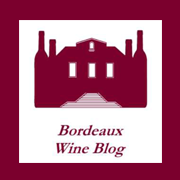
![20150118_174649[1]](http://www.bordeauxwineblog.com/wp-content/uploads/2015/01/20150118_1746491-e1421602751948-168x300.jpg)
![20150111_212736[1]](http://www.bordeauxwineblog.com/wp-content/uploads/2015/01/20150111_2127361-e1421417468812-168x300.jpg)
![20150111_212328[1]](http://www.bordeauxwineblog.com/wp-content/uploads/2015/01/20150111_2123281-e1421417965630-168x300.jpg)
![20150111_212534[1]](http://www.bordeauxwineblog.com/wp-content/uploads/2015/01/20150111_2125341-e1421417487557-168x300.jpg)
![20150107_084747[1]](http://www.bordeauxwineblog.com/wp-content/uploads/2015/01/20150107_0847471-e1421009398195-150x150.jpg)
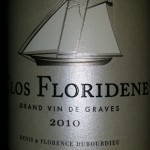
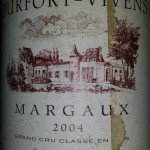
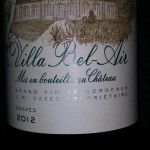
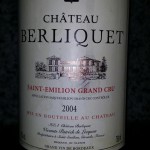
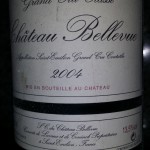
![20141106_094341[1]](http://www.bordeauxwineblog.com/wp-content/uploads/2014/11/20141106_0943411-150x150.jpg)
![20141026_112619[1]](http://www.bordeauxwineblog.com/wp-content/uploads/2014/10/20141026_1126191-e1414429345101-150x150.jpg)
